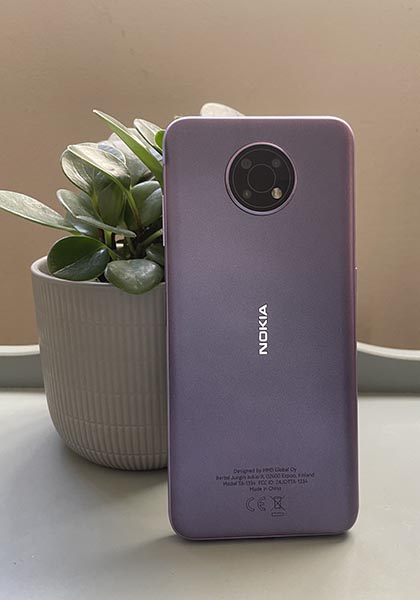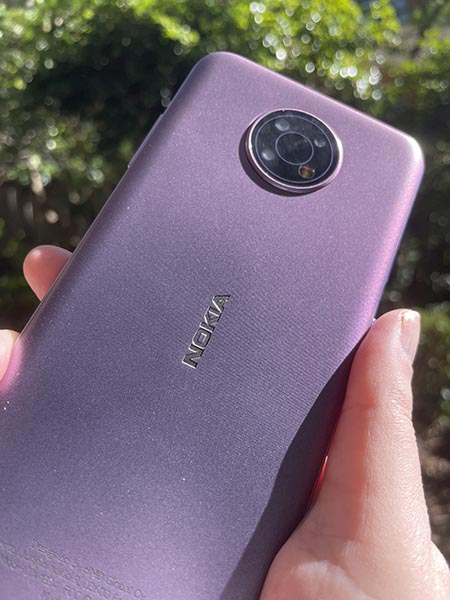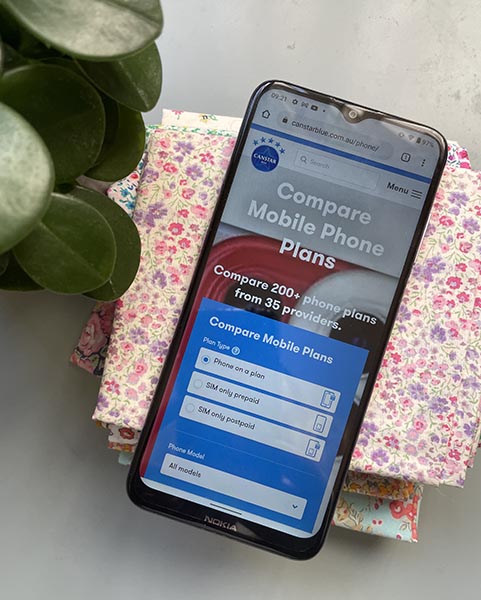Earlier in 2021, Nokia changed the way it releases phones, introducing a ‘series’ or ‘range’ based approach similar to competitors Samsung and OPPO. Rather than the numbering convention Nokia was using, phones are now released as part of a price-based series. The Nokia G series are the cheaper devices but with a little more than the C series (which are the absolute cheapest phones), and then the X series are the more premium end.
As one of the first in the new G series, the Nokia G10 is one of Nokia’s most affordable smartphones. Priced at $199 AUD RRP, the G10 is aimed at anyone looking for a smartphone that can do the day-to-day basics, but at a super-affordable sub-$200 price point. For a phone this cheap, what can you expect and how does it hold up? Let’s take a look.

Nokia G10 features & specs
Here are some of the features and specifications of the Nokia G10 phone:
- $199 AUD RRP
- 6.5 inch HD+ LCD display
- 32GB internal storage + expandable Micro SD storage up to 512GB
- 3GB RAM
- 5,050mAh battery
- Mediatek G25 8x A53 processor
- Fingerprint scanner (side button) + facial recognition for unlocking
- Triple rear-camera setup (13MP main + 2MP depth + 2MP macro)
- 8MP front-facing camera
- Runs Android 11 with 2 years OS upgrades and 3 years security upgrades
- Night and Dusk colourways
| Nokia G10 Pros | Nokia G10 Cons |
|---|---|
|
|
Jump to:
- Design and functionality
- Performance
- Cameras
- Should I buy the Nokia G10?
- Compare SIM-only phone plans

Design and functionality
Look and feel
First up is how the Nokia G10 looks. It’s available in a nice dark blue ‘Night’ colourway, but lucky for me, I was given the light purple ‘Dusk’ model to try out. On the back is a textured matte-metal looking finish and in the purple colour, you can really see the lined texture. It looks absolutely beautiful, and feels really nice and not at all cheap. The matte finish also doesn’t show fingerprints, so if you decide to forgo the included clear jelly case, you won’t need to worry about smudging.
It’s a decent sized phone — it’s not too huge if you have smaller hands, but big enough if you prefer larger phones. The display is fairly decent and when watching HD videos, does produce a nice clear result. The screen didn’t really do too well in bright sunlight however, so it’s hard to see what you’re taking a photo of if you’re outdoors in the sun.
Screen quality
Colours seem a little subdued on this display, however that’s a common trait I’ve found with several other Nokia phones. Although the quality is nice and clear, colours aren’t as vibrant as phones from other brands, such as Realme.
Unlocking
The G10 includes both facial and fingerprint unlocking, with the fingerprint scanner located on the side home button. Having both unlocking technologies seems to be a more common inclusion in cheaper phones now — a sign that this once premium technology is now better and more affordable than a few years ago. However, the unlocking was a little hit and miss. I found that at times it was ultra sensitive that the slightest bump of the fingerprint scanner would have it reacting and the screen lighting up, and it seemed that the tiniest glimpse of my face had it unlocking or reacting. This was slightly frustrating, as you can’t really move your phone or carry it around without it trying to unlock straight away, so you might want to pick either just fingerprint or face unlocking and not both. Occasionally it wouldn’t register my face, or would be a bit slow to register and unlock.
Overall, the design and functionality of the G10, considering the price point, is fantastic. The Nokia G10 also doesn’t look like a sub-$200 phone — it certainly doesn’t look cheap. Nokia does a good job at making sleek-looking phones, and it was nice to see such a beautiful finish, especially in the purple which is a colour popping up more and more these days.
Performance
Navigation and use
When it comes to the performance of the G10, first of all, you need to keep in mind that this is a $199 phone. That being said, the performance in general was ok, but just ok. It was slow to react and load at times. When I first turned the device on, setup was really slow: there was a big update that took a while to install, and I had a couple of issues, such as the Google Play store crashing and apps being slow to download.
I found navigating between apps to be quite slow at times, and the same for loading content in apps, especially video and pages that included video. Photos were a little slow to load in apps like Facebook, however it wasn’t too bad, it was more that the photos were loading one by one instead of all of them loading instantaneously. Scrolling through apps was also at times slow, not really fluid and slightly jumpy; however, this is pretty common in cheaper devices and for the most part, you probably won’t notice it.

One issue I did have was how slow the phone was to react to touch and movement. It took a while for videos to register screen rotation, or for gesture swipes to minimise video or apps. The camera app had a similar issue, where navigating between the different functions would require several taps or scrolls for it to register what I wanted it to do. I did find that it took a second or third tap for the phone to register when I was trying to pinch, slide or select/click on something. I had an issue where taking a photo froze the whole screen while processing the image and I needed to restart the device, which meant the photos I had just taken had disappeared.
Slow loading is to be expected with a cheaper phone that doesn’t have the highest quality CPU on the market, however the issues with reaction were more frustrating than slow load times. Also, the issues I had with the camera app are not something I would put solely down to the technology, as I’ve previously had some issues with camera apps in other Nokia devices before, including the Nokia 5.4.
Battery
The 5,050mAh battery packs a decent performance, and if you’re looking for a big battery at a cheaper price, this one certainly ticks the box. When the phone is idle, I experienced a battery drain of 40% in around 10 days. When watching 45 minutes of HD videos, it drained around 5% of battery, while around 4 hours of moderate usage drained about 13% of battery. Once your battery does drain, unfortunately it takes a while to get it up to 100% — I found that it took around three hours to charge from 0% to 100%, and it really seemed to struggle to charge that final bit from 99% to 100%.
Viewing experience
The screen provides a nice viewing experience with clear quality when watching HD videos. There is an auto-brightness feature, which at times was a little temperamental, as I found that if my shadow blocked some of the light source, the phone would register that as a change in brightness. Despite being in a well-lit room, the G10 would then darken the screen, which was frustrating when in the middle of reading something.
While the screen was great for watching videos, the built-in speakers were disappointing. The quality wasn’t great and had no depth to it, and at times the quality was so bad that music, especially live music videos, is just not worth it. Luckily, there is a headphone jack positioned at the top of the phone, which isn’t the best placement but it’s more of a personal preference. If you do listen to music and watch videos on your phone regularly, you might want to stick with the headphones. In addition to poor speaker quality, the volume control tended to be more quiet — by the time you increase volume maybe half way, it still sounds quite low, so you tend to need volume up quite high.
The performance of the Nokia G10 was a bit hit and miss. The glitches, slow loads and temperamental reactions were frustrating at times, although it wasn’t always a frequent occurrence. However, you need to keep into consideration the price point. Compared to a premium device, this will be a let down, but the price is still under $200. There aren’t many smartphones on the market as cheap, and if you want a phone for the basics, the slow performance isn’t really going to be a major issue.
Cameras
Perhaps what users might want to know most of all: how do cameras from a $199 phone stack up? The good news is that for the price point, the cameras seemed to take some decent photos and videos, although the camera app itself is what really lets down the G10. You’ll get a triple rear-camera setup with 13MP main lens, 2MP depth and 2MP macro, with a 8MP front-facing camera.

Outdoor photography is pretty decent and I was able to get some rather clear and vibrant pictures. Colours are rather true to life but a little subdued, which seems to be a trait with Nokia phones in general. Panorama mode is easy to use and the results were consistent, however focus tended to be a bit blurry when you take a closer look. Zooming in to take photos also lost some of the vibrancy of colours, and focus was a little blurry.

Indoor photos are a little more on the grainy side, which is common in many other cheaper phones. Low light and indoor photos are pretty much useless with dark, blurry and grainy photos, however night mode does a decent job at lightening in low light situations.

The macro lens was somewhat surprising. Usually macro in cheap phones is rather disappointing and not really worth using, but I found I was able to take some really great macro shots. Macro in low light is where it drops off — playing into the general issue with low light photography in cheap phones — but I was able to grab clear focus on objects. You’ll take a few goes to get the right depth and clarity to your macro shots, but I didn’t find it too much of a struggle.

Portrait photography is a little surprising — when I was using the mode, the blur around the subject was a little artificial, which seems to be a common trait with portrait mode in other cheap devices. However the result of the photo was much better than what it looked like when I was taking the picture. You’ll also get the background bokeh effect on lights when shooting in portrait mode, which seems to be a standard feature for Nokia phones now.
Shooting video is very basic, with time lapse the only video feature included. It does an ok job, but I found panning to be a little jumpy, and if you need to zoom in and out, it’s not a smooth zoom at all.
The cameras were overall what you can expect in a device at this price. It does a decent job at the basics and I even found some photo modes almost exceeded expectations. The G10 is great if you don’t tend to take many photos or videos and don’t need much from those functions, however the decent cameras are let down by a laggy and glitchy camera app.
Should I buy the Nokia G10?
The most important thing to consider when looking at the Nokia G10 is the price. For $199, you can’t expect top quality features and technology, and that’s true for most phones in this price range.
With the price in mind, the G10 does a good job at the basics. If you are more focussed on a device that works on the day to day, has a good battery and can get you online, on social media and take photos on occasion, it will definitely fill that need. The intermittent slow performance is a little frustrating at times, however if you don’t tend to use your phone too much, or don’t use social media, you might not run into this problem as much as someone who uses their phone more.
| Consider the Nokia G10 if | Don’t consider the Nokia G10 if |
|---|---|
| You’re looking for a phone for under $200 that does the basics with a decent camera setup. | You use a lot of different apps, especially with pictures and videos, and are a heavier phone user. |
Compare SIM-only plans
As you can only buy the Nokia G10 outright from select retailers, you’ll need to pair your phone with a SIM-only plan. If you’re in the market for a new SIM-only phone plan you can choose between postpaid or prepaid plans, with lots of cheap plans and big data plans available.
Here is a selection of postpaid plans from Canstar Blue’s database with a minimum of 20GB of data, listed in order of standard cost, lowest to highest, then by data allowance, largest to smallest. Try using our mobile phone plan comparison tool to see a wide range of plans from other providers. This table includes products with links to referral partners.
Here is a selection of prepaid plans from Canstar Blue’s database with a minimum of 10GB of data each month, listed in order of standard cost, lowest to highest, then by data allowance, largest to smallest. If you want to compare a larger range of offers from other providers, use our phone plan comparison tool. This table includes products with links to referral partners.
Related articles:
- OPPO A54 5G review: The latest technology is no longer a premium feature
- OPPO A53 review: A pretty phone with a great battery
- OPPO A15 phone review: A surprising performance for a cheap price
- Cheap phones compared: $200 vs $300 vs $400 phone review
- Nokia 8.3 5G Review: A premium 5G device from a trusted brand
Product used for review/testing was a free sample provided by Nokia/HMD Global.


Share this article